
Nowa Huta
Encyclopedia

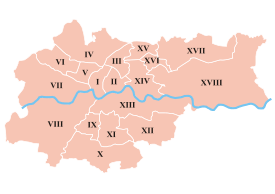
Districts of Kraków
The city of Kraków is divided into 18 administrative districts, each with a degree of autonomy within the municipal government. The Polish name for such a district is dzielnica....
of Kraków
Kraków
Kraków also Krakow, or Cracow , is the second largest and one of the oldest cities in Poland. Situated on the Vistula River in the Lesser Poland region, the city dates back to the 7th century. Kraków has traditionally been one of the leading centres of Polish academic, cultural, and artistic life...
, Poland
Poland
Poland , officially the Republic of Poland , is a country in Central Europe bordered by Germany to the west; the Czech Republic and Slovakia to the south; Ukraine, Belarus and Lithuania to the east; and the Baltic Sea and Kaliningrad Oblast, a Russian exclave, to the north...
, (District XVIII, see map). With more than 200,000 inhabitants it is one of the most populous areas of the city.
History
The historic area of present-day Nowa Huta is one of the few places in PolandPoland
Poland , officially the Republic of Poland , is a country in Central Europe bordered by Germany to the west; the Czech Republic and Slovakia to the south; Ukraine, Belarus and Lithuania to the east; and the Baltic Sea and Kaliningrad Oblast, a Russian exclave, to the north...
settled continuously since neolithic
Neolithic
The Neolithic Age, Era, or Period, or New Stone Age, was a period in the development of human technology, beginning about 9500 BC in some parts of the Middle East, and later in other parts of the world. It is traditionally considered as the last part of the Stone Age...
times. Archeological research has discovered a big Celt
Celt
The Celts were a diverse group of tribal societies in Iron Age and Roman-era Europe who spoke Celtic languages.The earliest archaeological culture commonly accepted as Celtic, or rather Proto-Celtic, was the central European Hallstatt culture , named for the rich grave finds in Hallstatt, Austria....
ic settlement and Poland's oldest Slavic
Slavic peoples
The Slavic people are an Indo-European panethnicity living in Eastern Europe, Southeast Europe, North Asia and Central Asia. The term Slavic represents a broad ethno-linguistic group of people, who speak languages belonging to the Slavic language family and share, to varying degrees, certain...
settlements there. A mound was erected by Vistulans
Vistulans
Vistulans were an early medieval West Slavic tribe inhabiting the land of modern Lesser Poland.From the 1st century and possibly earlier, the Vistulans , were part of the Carpian Tribe, which got its name from the area that they lived in, which was beside the Carpathian Mountain Range...
in the 8th century. According to legend, the Wanda Mound
Wanda Mound
Wanda Mound is a tumulus located in Mogiła in Kraków, Poland. The mound is assumed to be the resting place of the legendary princess Wanda. According to one version of the story, she committed suicide by drowning in the Vistula river to avoid unwanted marriage...
is a tomb of Wanda, daughter of Krak, a mythical founder of Kraków. In the 13th century a Cistercian monastery
Monastery
Monastery denotes the building, or complex of buildings, that houses a room reserved for prayer as well as the domestic quarters and workplace of monastics, whether monks or nuns, and whether living in community or alone .Monasteries may vary greatly in size – a small dwelling accommodating only...
in the village of Mogiła was built.
In the 19th century and in the beginning of 20th century up to the First World War the outskirts of Nowa Huta constituted a border between Austria
Austria
Austria , officially the Republic of Austria , is a landlocked country of roughly 8.4 million people in Central Europe. It is bordered by the Czech Republic and Germany to the north, Slovakia and Hungary to the east, Slovenia and Italy to the south, and Switzerland and Liechtenstein to the...
and Russia
Russia
Russia or , officially known as both Russia and the Russian Federation , is a country in northern Eurasia. It is a federal semi-presidential republic, comprising 83 federal subjects...
. One can find Austro-Hungarian forts there and one of Europe's oldest permanent airfields (Kraków-Rakowice-Czyżyny Airport
Kraków-Rakowice-Czyzyny Airport
Kraków-Rakowice-Czyżyny Airport is a disused airport in Kraków, Poland, one of the oldest permanent airfields in Europe, open for occasional traffic by certain types of aircraft...
, currently housing the Polish Aviation Museum
Polish Aviation Museum
Polish Aviation Museum is a large museum of old aircraft and aircraft engines in Kraków, Poland. It is located at the site of the no-longer functional Kraków-Rakowice-Czyżyny Airport. This airfield, established by Austria-Hungary in 1912, is one of the oldest in the world...
).
Following the establishing of the People's Republic of Poland
People's Republic of Poland
The People's Republic of Poland was the official name of Poland from 1952 to 1990. Although the Soviet Union took control of the country immediately after the liberation from Nazi Germany in 1944, the name of the state was not changed until eight years later...
in 1945, the Communist authorities had encountered substantial resistance to their new regime from middle-class Cracovians. A referendum held by the authorities was soundly defeated by the people of Kraków - a major cause of embarrassment for the Government. To "correct the class imbalance", the authorities commenced building a satellite industrial town to attract people from lower socioeconomic backgrounds to the region, such as peasants and the working class.
Nowa Huta was started in 1949 as a separate town near Kraków
Kraków
Kraków also Krakow, or Cracow , is the second largest and one of the oldest cities in Poland. Situated on the Vistula River in the Lesser Poland region, the city dates back to the 7th century. Kraków has traditionally been one of the leading centres of Polish academic, cultural, and artistic life...
on terrain resumed by the Communist Government from former villages of Mogiła, Pleszów and Krzesławice. It was planned as a huge centre of heavy industry. The town was to become an ideal town for the communist propaganda and populated mostly by industrial workers. In 1951 it was joined with Kraków as its new district and the following year tramway communication was started.

Tadeusz Sendzimir Steelworks
Tadeusz Sendzimir Steelworks is the second largest steel plant in Poland. It opened on July 22, 1954 in a newly-built, easternmost district of Kraków called Nowa Huta. The steelworks as well as the district were located in the area formerly occupied by the village of Mogiła and surrounding...
was opened and in less than 20 years the factory became the biggest steel mill
Steel mill
A steel mill or steelworks is an industrial plant for the manufacture of steel.Steel is an alloy of iron and carbon. It is produced in a two-stage process. First, iron ore is reduced or smelted with coke and limestone in a blast furnace, producing molten iron which is either cast into pig iron or...
in Poland
Poland
Poland , officially the Republic of Poland , is a country in Central Europe bordered by Germany to the west; the Czech Republic and Slovakia to the south; Ukraine, Belarus and Lithuania to the east; and the Baltic Sea and Kaliningrad Oblast, a Russian exclave, to the north...
. In the 1960s the city grew rapidly. The monumental architecture of the Central Square (Plac Centralny) was surrounded by huge blocks of flats. In the 1970s the steel
Steel
Steel is an alloy that consists mostly of iron and has a carbon content between 0.2% and 2.1% by weight, depending on the grade. Carbon is the most common alloying material for iron, but various other alloying elements are used, such as manganese, chromium, vanadium, and tungsten...
production reached 7 millions tonnes of steel yearly. At the same time the biggest tobacco
Tobacco
Tobacco is an agricultural product processed from the leaves of plants in the genus Nicotiana. It can be consumed, used as a pesticide and, in the form of nicotine tartrate, used in some medicines...
factory in Poland was opened there and a huge cement
Cement
In the most general sense of the word, a cement is a binder, a substance that sets and hardens independently, and can bind other materials together. The word "cement" traces to the Romans, who used the term opus caementicium to describe masonry resembling modern concrete that was made from crushed...
factory.
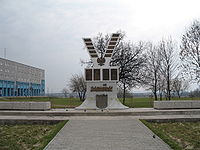
Kraków
Kraków also Krakow, or Cracow , is the second largest and one of the oldest cities in Poland. Situated on the Vistula River in the Lesser Poland region, the city dates back to the 7th century. Kraków has traditionally been one of the leading centres of Polish academic, cultural, and artistic life...
were mostly ideological
Communism
Communism is a social, political and economic ideology that aims at the establishment of a classless, moneyless, revolutionary and stateless socialist society structured upon common ownership of the means of production...
and were against laws of economy
Market economy
A market economy is an economy in which the prices of goods and services are determined in a free price system. This is often contrasted with a state-directed or planned economy. Market economies can range from hypothetically pure laissez-faire variants to an assortment of real-world mixed...
(coal had to be transported from Silesia
Silesia
Silesia is a historical region of Central Europe located mostly in Poland, with smaller parts also in the Czech Republic, and Germany.Silesia is rich in mineral and natural resources, and includes several important industrial areas. Silesia's largest city and historical capital is Wrocław...
and iron ore from the Soviet Union
Soviet Union
The Soviet Union , officially the Union of Soviet Socialist Republics , was a constitutionally socialist state that existed in Eurasia between 1922 and 1991....
; the products were shipped to other parts of Poland since local demand was relatively small). This became visible in the 1980s, when the economic crisis halted the city's growth.
One type of building lacking from the original urban design of Nowa Huta was a Roman Catholic church. The public campaign to construct it lasted several years. As early as 1960, inhabitants of Nowa Huta began applying for permit to build a church. In that year, violent street fights with riot-police erupted over a wooden cross, erected without a permit. The locals were supported by Bishop Karol Wojtyla and eventually, a church called the Lord's Arc was built. The complex was consecrated by Wojtyla in 1977. Wojtyla himself, after being elected Pope in 1978, wanted to visit Nowa Huta during his first papal pilgrimage in 1979, but was not permitted to do so.
In the 1980s Nowa Huta became a place of many demonstrations and violent street protests of the Solidarity movement, fought by the police. At that time, almost 29,000 of the 38,000 workers of the then Lenin's Steelworks belonged to the Trade Union "Solidarity".
Before 1956 (Socialist Realism)

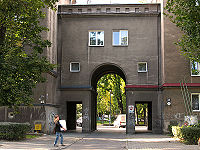
Socialist realism
Socialist realism is a style of realistic art which was developed in the Soviet Union and became a dominant style in other communist countries. Socialist realism is a teleologically-oriented style having its purpose the furtherance of the goals of socialism and communism...
in Poland
Poland
Poland , officially the Republic of Poland , is a country in Central Europe bordered by Germany to the west; the Czech Republic and Slovakia to the south; Ukraine, Belarus and Lithuania to the east; and the Baltic Sea and Kaliningrad Oblast, a Russian exclave, to the north...
, as in other countries of the People's Republic
People's Republic
People's Republic is a title that has often been used by Marxist-Leninist governments to describe their state. The motivation for using this term lies in the claim that Marxist-Leninists govern in accordance with the interests of the vast majority of the people, and, as such, a Marxist-Leninist...
s, was enforced from 1949 to 1956. It involved all domains of art, but its most spectacular achievements were made in the field of architecture
Architecture
Architecture is both the process and product of planning, designing and construction. Architectural works, in the material form of buildings, are often perceived as cultural and political symbols and as works of art...
. The main lines of this new trend were very precisely indicated in a 1949 resolution of the National Council of Party Architects. Architecture was an extremely important weapon to the creators of a new social order. It was intended to help to form a socialist theme - the ideas sparking citizens' consciousness and outlook on life. During this great work, a crucial role fell to an architect who wasn't perceived as merely an engineer creating streets and edifices, but an "engineer of the human soul
Engineers of the human soul
Engineers of the human soul was a term applied to writers and other cultural workers by Joseph Stalin.The phrase was apparently coined by Yury Olesha; Viktor Shklovsky said that Olesha used it in a meeting with Stalin at the home of Maxim Gorky, and it was subsequently used by Stalin, who said...
". The general outlook of a building was more valued than its simple aesthetics. It needed to express social ideas, to arouse a feeling of persistence and power.
Since the style of the Renaissance
Renaissance
The Renaissance was a cultural movement that spanned roughly the 14th to the 17th century, beginning in Italy in the Late Middle Ages and later spreading to the rest of Europe. The term is also used more loosely to refer to the historical era, but since the changes of the Renaissance were not...
was generally regarded as the most revered in old Polish architecture, it was to become also Poland's socialist national format. However, in the course of incorporating the principles of socialist realism, there were quite a few deviations introduced. One of these was to more closely reflect Soviet architecture, which resulted in the majority of works blending into one another; and finally the general acceptance of the classicist form. From 1953, critical opinions were increasingly frequently heard, and the doctrine was finally given up in 1956. Currently the socrealist city centre is considered a monument of architecture.
After 1956
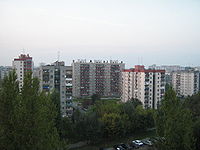
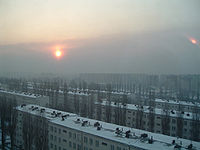
Polish October
Polish October, also known as October 1956, Polish thaw, or Gomułka's thaw, marked a change in the Polish internal political scene in the second half of 1956...
in 1956 it became possible to introduce modernist
Modern architecture
Modern architecture is generally characterized by simplification of form and creation of ornament from the structure and theme of the building. It is a term applied to an overarching movement, with its exact definition and scope varying widely...
style in architecture. Polish architects were allowed to visit Stockholm
Stockholm
Stockholm is the capital and the largest city of Sweden and constitutes the most populated urban area in Scandinavia. Stockholm is the most populous city in Sweden, with a population of 851,155 in the municipality , 1.37 million in the urban area , and around 2.1 million in the metropolitan area...
to learn about newest solutions in urban design. As the result, the so-called "Swedish" apartment block was developed according to Le Corbusier
Le Corbusier
Charles-Édouard Jeanneret, better known as Le Corbusier , was a Swiss-born French architect, designer, urbanist, writer and painter, famous for being one of the pioneers of what now is called modern architecture. He was born in Switzerland and became a French citizen in 1930...
guidelines. Among other buildings from that era, Światowid cinema is worth noting. In the 1980s first postmodernist
Postmodern architecture
Postmodern architecture began as an international style the first examples of which are generally cited as being from the 1950s, but did not become a movement until the late 1970s and continues to influence present-day architecture...
buildings were built (Centrum E housing estate). In 1970s and 1980s most blocks of flats
Tower block
A tower block, high-rise, apartment tower, office tower, apartment block, or block of flats, is a tall building or structure used as a residential and/or office building...
were built using plattenbau
Plattenbau
Plattenbau is the German word for a building whose structure is constructed of large, prefabricated concrete slabs. The word is a compound of Platte and Bau...
.
Nowa Huta's central avenue featured a countrywide known statue of Vladimir Lenin
Vladimir Lenin
Vladimir Ilyich Lenin was a Russian Marxist revolutionary and communist politician who led the October Revolution of 1917. As leader of the Bolsheviks, he headed the Soviet state during its initial years , as it fought to establish control of Russia in the Russian Civil War and worked to create a...
that was pulled down in 1989 by anti-revolutionary forces.
Also sacral architecture should be noted, especially Arka Pana (Lord's Ark) church, which was built to resemble Noah's Ark
Noah's Ark
Noah's Ark is a vessel appearing in the Book of Genesis and the Quran . These narratives describe the construction of the ark by Noah at God's command to save himself, his family, and the world's animals from the worldwide deluge of the Great Flood.In the narrative of the ark, God sees the...
. It was designed by the architects Wojciech Pietrzyk and Jan Grabacki, with the design being influenced by Le Corbusier
Le Corbusier
Charles-Édouard Jeanneret, better known as Le Corbusier , was a Swiss-born French architect, designer, urbanist, writer and painter, famous for being one of the pioneers of what now is called modern architecture. He was born in Switzerland and became a French citizen in 1930...
's Notre Dame du Haut
Notre Dame du Haut
Informally known as "Ronchamp", the chapel of Notre Dame du Haut in Ronchamp , completed in 1954, is one of the finest examples of the architecture of Franco-Swiss architect Le Corbusier and one of the most important examples of twentieth-century religious architecture.-History:Notre Dame du Haut...
in Ronchamp
Ronchamp
Ronchamp is a commune in the Haute-Saône department in the region of Franche-Comté in eastern France.It is located between the Vosges and the Jura mountains.-Notre Dame du Haut:...
.
Nowa Huta Today
Since the fall of Communism the city that was once a showpiece for Stalinism now boasts many tributes to ardent anti-Communists. Streets formerly named after Lenin and the Cuban RevolutionCuban Revolution
The Cuban Revolution was an armed revolt by Fidel Castro's 26th of July Movement against the regime of Cuban dictator Fulgencio Batista between 1953 and 1959. Batista was finally ousted on 1 January 1959, and was replaced by a revolutionary government led by Castro...
have been renamed to honor Pope John Paul II and the Polish exile leader Władysław Anders. In 2004 Plac Centralny, Nowa Huta's central square which once was home to a giant statue of Lenin - on display at High Chaparral Museum in Hillerstorp
Hillerstorp
Hillerstorp is a locality situated in Gnosjö Municipality, Jönköping County, Sweden with 1,806 inhabitants in 2005. About 40% of the companies in Gnosjö municipality are located in Hillerstorp.Various small industries dominate the landscape...
, Sweden
Sweden
Sweden , officially the Kingdom of Sweden , is a Nordic country on the Scandinavian Peninsula in Northern Europe. Sweden borders with Norway and Finland and is connected to Denmark by a bridge-tunnel across the Öresund....
, was renamed Ronald Reagan
Ronald Reagan
Ronald Wilson Reagan was the 40th President of the United States , the 33rd Governor of California and, prior to that, a radio, film and television actor....
Central Square (Plac Centralny im. Ronalda Reagana) in honor of the former U.S. President. However, this decision led to many protests, and the traditional name is still widely used.
Landmarks
- Wanda MoundWanda MoundWanda Mound is a tumulus located in Mogiła in Kraków, Poland. The mound is assumed to be the resting place of the legendary princess Wanda. According to one version of the story, she committed suicide by drowning in the Vistula river to avoid unwanted marriage...
, (8th century) - Cistercian abbeyAbbeyAn abbey is a Catholic monastery or convent, under the authority of an Abbot or an Abbess, who serves as the spiritual father or mother of the community.The term can also refer to an establishment which has long ceased to function as an abbey,...
in Mogiła (1225) - Jan MatejkoJan MatejkoJan Matejko was a Polish painter known for paintings of notable historical Polish political and military events. His most famous works include oil on canvas paintings like Battle of Grunwald, paintings of numerous other battles and court scenes, and a gallery of Polish kings...
manor in Krzesławice - Branice manor
- St. Wenceslaus Church (1226)
- St. Bartholomew Church (1466)
- Austro-Hungarian forts: Batowice, Mistrzejowice, Dłubnia, Krzesławice, Grębałów, Mogiła
- Tadeusz SendzimirTadeusz SendzimirTadeusz Sendzimir of Ostoja coat of arms was a Polish engineer and inventor of international renown with 120 patents in mining and metallurgy, 73 of which were awarded to him in the United States.His name has been given to revolutionary methods of processing steel and metals used in every...
Steel Mill (formerly Vladimir LeninVladimir LeninVladimir Ilyich Lenin was a Russian Marxist revolutionary and communist politician who led the October Revolution of 1917. As leader of the Bolsheviks, he headed the Soviet state during its initial years , as it fought to establish control of Russia in the Russian Civil War and worked to create a...
Steel Works) - Plac Centralny, and Aleja Róż (Avenue of Roses) architecture
- Arka Pana (Lord's Ark) church and Chapel of Conciliation in Bieńczyce
- Polish Aviation MuseumPolish Aviation MuseumPolish Aviation Museum is a large museum of old aircraft and aircraft engines in Kraków, Poland. It is located at the site of the no-longer functional Kraków-Rakowice-Czyżyny Airport. This airfield, established by Austria-Hungary in 1912, is one of the oldest in the world...
in Czyżyny - Branch of the Historical Museum of KrakówHistorical Museum of KrakówHistorical Museum of Kraków a.k.a. Historical Museum of the City of Kraków at the Krzysztofory Palace in Kraków, Poland, was granted the status of an independent institution in 1945...
, History of Nowa Huta
Cultural significance
The Andrzej WajdaAndrzej Wajda
Andrzej Wajda is a Polish film director. Recipient of an honorary Oscar, he is possibly the most prominent member of the unofficial "Polish Film School"...
film, Man of Marble
Man of Marble
Man of Marble is a 1976 Polish film directed by Andrzej Wajda. It chronicles the fall from grace of a fictional heroic Polish bricklayer, Mateusz Birkut , who became the Stakhanovite symbol of an over-achieving worker, in Nowa Huta, a new socialist city near Kraków...
, is based in Nowa Huta and chronicles the life of a bricklayer who helps build the new model socialist city. Man of Marble, made in the mid 1970s, presaged the Solidarity labor union movement in Gdańsk
Gdansk
Gdańsk is a Polish city on the Baltic coast, at the centre of the country's fourth-largest metropolitan area.The city lies on the southern edge of Gdańsk Bay , in a conurbation with the city of Gdynia, spa town of Sopot, and suburban communities, which together form a metropolitan area called the...
that was ultimately responsible for overthrowing Communism, as the film that starts in Nowa Huta ends in Gdańsk.
Widely promoted popular songs in 1950s, when the district was built, included "O Nowej to Hucie piosenka" (This Song is about Nowa Huta) featured here with the video. The song is still well remembered by many Poles especially of the older generation.
The Presumed Miracle, or Krakovians and Highlanders by Wojciech Bogusławski, Poland's first-ever opera
Opera
Opera is an art form in which singers and musicians perform a dramatic work combining text and musical score, usually in a theatrical setting. Opera incorporates many of the elements of spoken theatre, such as acting, scenery, and costumes and sometimes includes dance...
http://www.culture.pl/en/culture/artykuly/os_boguslawski_wojciech written in 1794 is set in the village of Mogiła, in the territory where Nowa Huta was built. Housing estates osiedle Krakowiaków (The Krakovians Estate) and osiedle Górali (The Highlanders Estate) are named after characters of the play. It was also the first drama played upon opening the Ludowy Theatre
Ludowy Theatre
The Ludowy Theatre in Kraków, located at Osiedle Teatralne in District Nowa Huta, opened on December 3, 1955; at a time, when the official policy of Socialist realism came to an end; and, the 1956 de-stalinization of People's Republic of Poland was about to begin...
.
Oedipus - a tragedy from Nowa Huta is a play
Play (theatre)
A play is a form of literature written by a playwright, usually consisting of scripted dialogue between characters, intended for theatrical performance rather than just reading. There are rare dramatists, notably George Bernard Shaw, who have had little preference whether their plays were performed...
based on ancient Greek myth
Greek mythology
Greek mythology is the body of myths and legends belonging to the ancient Greeks, concerning their gods and heroes, the nature of the world, and the origins and significance of their own cult and ritual practices. They were a part of religion in ancient Greece...
about Oedipus
Oedipus
Oedipus was a mythical Greek king of Thebes. He fulfilled a prophecy that said he would kill his father and marry his mother, and thus brought disaster on his city and family...
, premiered in Łaźnia Nowa Theatre under direction of Bartosz Szydłowski
In 2004 Austrian artist Tassilo Blittersdorff interpreted and variated photos of the socialist architecture and the interaction of the inhabitants with the buildings (pictured).
Venues
- Teatr Ludowy (The People's Theatre), Nowa Huta's oldest theatre
- Łaźnia Nowa TheatreLaznia Nowa TheatreŁaźnia Nowa Theatre is the youngest dramatic theatre in Kraków, Poland. It is located in the district of Nowa Huta which was built from the ground up during the 1950s' Communist policy of Socialist realism. Appropriately, the theatre is residing in post-industrial halls.Łaźnia Nowa Theatre was...
- Sfinks art-house cinema
- The Nowa Huta Cultural Centre
- The Cyprian NorwidCyprian NorwidCyprian Kamil Norwid, a.k.a. Cyprian Konstanty Norwid is a nationally esteemed Polish poet, dramatist, painter, and sculptor. He was born in the Masovian village of Laskowo-Głuchy near Warsaw. One of his maternal ancestors was Polish King John III Sobieski.Norwid is regarded as one of the second...
Cultural Centre
Industry
- Tadeusz Sendzimir Steel MillTadeusz Sendzimir SteelworksTadeusz Sendzimir Steelworks is the second largest steel plant in Poland. It opened on July 22, 1954 in a newly-built, easternmost district of Kraków called Nowa Huta. The steelworks as well as the district were located in the area formerly occupied by the village of Mogiła and surrounding...
owned by Mittal Steel CompanyMittal Steel CompanyMittal Steel Company N.V. was one of the world's largest steel producers by volume, and also one of the largests in turnover. The company is now part of ArcelorMittal.... - Kraków Power Station
- Philip MorrisPhilip Morris InternationalPhilip Morris International is an international tobacco company, with products sold in over 160 countries. In 2007, it held a 15.6% share of the international cigarette market outside of the USA and reported revenues net of excise taxes of $22.8 billion and operating income of $8.9 billion.Until...
Cigarettes Co. - ComArchComarchComarch is an international software house and systems integrator based in Kraków, Poland. Comarch provides services in areas such as Telecommunications, Finance and Banking, the Services Sector and to Public Administration...
, an international software house - INTERIA.PLInteria.plInteria.pl is a large Polish web portal and a popular search engine created in 1999 in Nowa Huta district of Kraków, Poland. It offers, among others: new email accounts, free web hosting, and domain name registration...
, a company operating Poland's third biggest portal
Education
- Faculty of Mechanical Engineering, Cracow University of TechnologyCracow University of TechnologyTadeusz Kościuszko University of Technology is a university located in downtown Kraków, Poland, established in 1946 and, as an institution of higher learning granted full autonomy in 1954....
- Academy of Physical Education
See also
- Głos – Tygodnik NowohuckiGłos – Tygodnik NowohuckiThe Głos – Tygodnik Nowohucki is a weekly magazine published in Kraków, Poland, focused on regional news concerning the largest and most populous city district of Nowa Huta. It features weekly editorials about politics, economy, culture, history of the city and the arts...
- KrakówKrakówKraków also Krakow, or Cracow , is the second largest and one of the oldest cities in Poland. Situated on the Vistula River in the Lesser Poland region, the city dates back to the 7th century. Kraków has traditionally been one of the leading centres of Polish academic, cultural, and artistic life...
- History of KrakówHistory of KrakówKraków is one of the largest and oldest cities in Poland, with the urban population of 756,441 . Situated on the Vistula river in the Lesser Poland region, the city dates back to the 7th century. It was the capital of Poland from 1038 to 1596, the capital of the Grand Duchy of Kraków from 1846 to...
- EisenhüttenstadtEisenhüttenstadtEisenhüttenstadt is a town in the Oder-Spree district of Brandenburg, Germany at the border with Poland. The town was founded in 1950 alongside a new steel mill as a socialist model city and has a population of 32,214...
- MagnitogorskMagnitogorskMagnitogorsk is a mining and industrial city in Chelyabinsk Oblast, Russia, located on the eastern side of the extreme southern extent of the Ural Mountains by the Ural River. Population: 418,545 ;...

